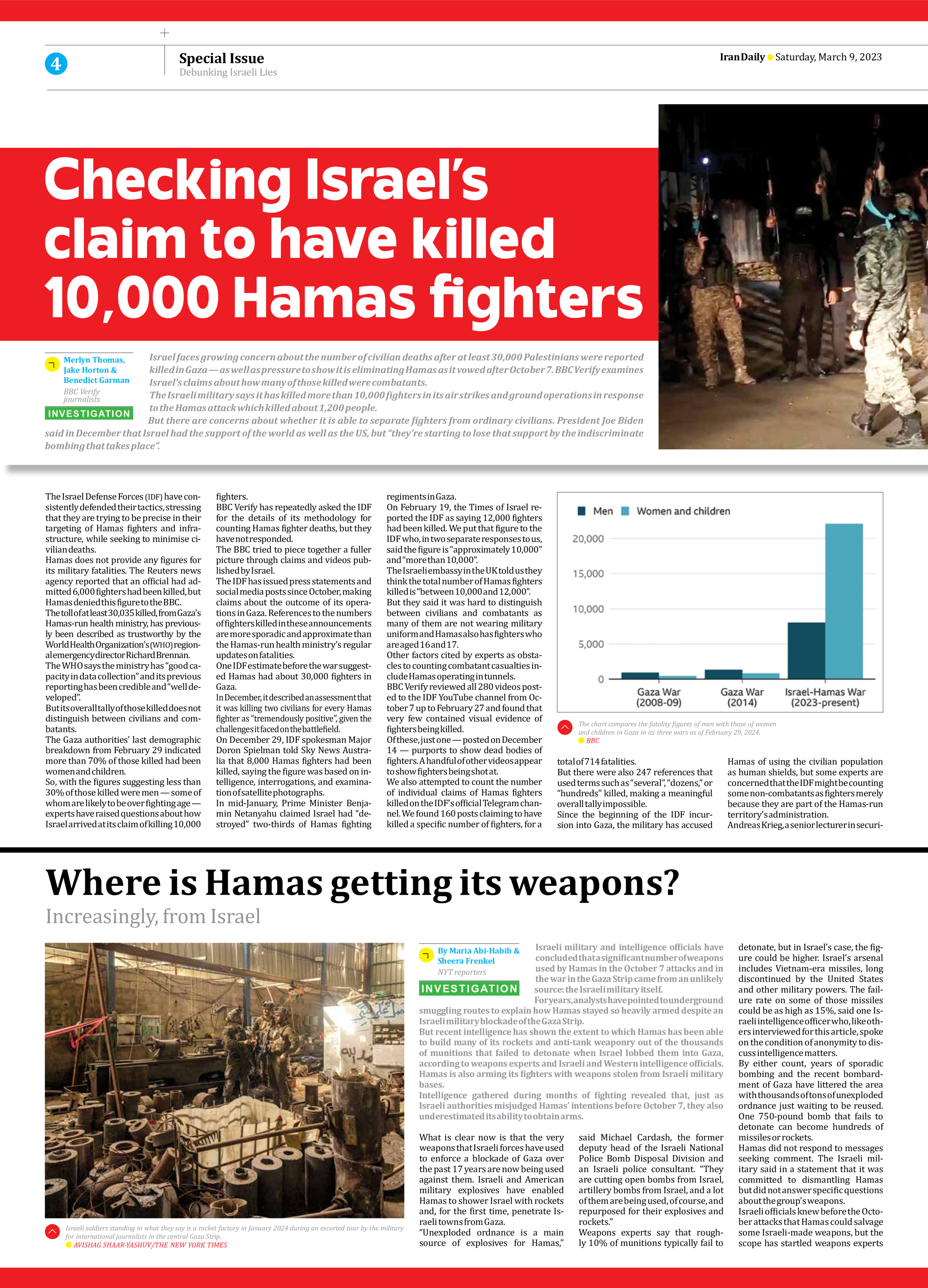
Where is Hamas getting its weapons?
Increasingly, from Israel
By Maria Abi-Habib & Sheera Frenkel
NYT reporters
Israeli military and intelligence officials have concluded that a significant number of weapons used by Hamas in the October 7 attacks and in the war in the Gaza Strip came from an unlikely source: the Israeli military itself.
For years, analysts have pointed to underground smuggling routes to explain how Hamas stayed so heavily armed despite an Israeli military blockade of the Gaza Strip.
But recent intelligence has shown the extent to which Hamas has been able to build many of its rockets and anti-tank weaponry out of the thousands of munitions that failed to detonate when Israel lobbed them into Gaza, according to weapons experts and Israeli and Western intelligence officials. Hamas is also arming its fighters with weapons stolen from Israeli military bases.
Intelligence gathered during months of fighting revealed that, just as Israeli authorities misjudged Hamas’ intentions before October 7, they also underestimated its ability to obtain arms.
What is clear now is that the very weapons that Israeli forces have used to enforce a blockade of Gaza over the past 17 years are now being used against them. Israeli and American military explosives have enabled Hamas to shower Israel with rockets and, for the first time, penetrate Israeli towns from Gaza.
“Unexploded ordnance is a main source of explosives for Hamas,” said Michael Cardash, the former deputy head of the Israeli National Police Bomb Disposal Division and an Israeli police consultant. “They are cutting open bombs from Israel, artillery bombs from Israel, and a lot of them are being used, of course, and repurposed for their explosives and rockets.”
Weapons experts say that roughly 10% of munitions typically fail to detonate, but in Israel’s case, the figure could be higher. Israel’s arsenal includes Vietnam-era missiles, long discontinued by the United States and other military powers. The failure rate on some of those missiles could be as high as 15%, said one Israeli intelligence officer who, like others interviewed for this article, spoke on the condition of anonymity to discuss intelligence matters.
By either count, years of sporadic bombing and the recent bombardment of Gaza have littered the area with thousands of tons of unexploded ordnance just waiting to be reused. One 750-pound bomb that fails to detonate can become hundreds of missiles or rockets.
Hamas did not respond to messages seeking comment. The Israeli military said in a statement that it was committed to dismantling Hamas but did not answer specific questions about the group’s weapons.
Israeli officials knew before the October attacks that Hamas could salvage some Israeli-made weapons, but the scope has startled weapons experts and diplomats alike.
Israeli authorities also knew that their armories were vulnerable to theft. A military report from early last year noted that thousands of bullets and hundreds of guns and grenades had been stolen from poorly guarded bases.
From there, the report said, some made their way to the West Bank, and others to Gaza by way of Sinai, but the report focused on military security. The consequences were treated almost as an afterthought: “We are fueling our enemies with our own weapons,” read one line of the report, which was viewed by The New York Times.
The consequences became apparent on October 7. Hours after Hamas breached the border, four Israeli soldiers discovered the body of a Hamas gunman who was killed outside the Re’im military base. Hebrew writing was visible on a grenade on his belt, said one of the soldiers, who recognized it as a bulletproof Israeli grenade, a recent model. Other Hamas fighters overran the base, and Israeli military officials say some weapons were looted and returned to Gaza.
A few miles away, members of an Israeli forensic team collected one of the 5,000 rockets fired by Hamas that day. Examining the rocket, they discovered that its military-grade explosives had most likely come from an unexploded Israeli missile fired into Gaza during a previous war, according to an Israeli intelligence officer.
One Western military official said that most of the explosives that Hamas is using in its war with Israel appear to have been manufactured using unexploded Israeli-launched munitions. One example, the official said, was an explosive booby trap that killed 10 Israeli soldiers in December.
Hamas cannot manufacture everything. Some things are easier to buy from the black market and smuggle into Gaza. Sinai, the largely uninhabited desert region between Israel, Egypt, and the Gaza Strip, remains a hub for arms smuggling. Weapons from conflicts in Libya, Eritrea, and Afghanistan have been discovered in Sinai, according to Israeli intelligence assessments.
According to two Israeli intelligence officials, at least a dozen small tunnels were still running between Gaza and Egypt before October 7. A spokesperson for the Egyptian government said its military had done its part to shut down tunnels on its side of the border. “Many of the weapons currently inside the Gaza Strip are the result of smuggling from within Israel,” the spokesperson said in an email.
Israel estimates that it has conducted at least 22,000 strikes on Gaza since October 7. Each often involves multiple rounds, meaning tens of thousands of munitions have likely been dropped or fired — and thousands failed to detonate.
“Artillery, hand grenades, other munitions — tens of thousands of unexploded ordnance — will be left after this war,” said Charles Birch, the head of the UN Mine Action Service in Gaza. These “are like a free gift to Hamas”.
The article first appeared on The New York Times.







